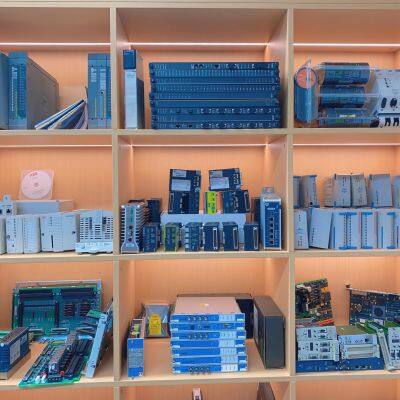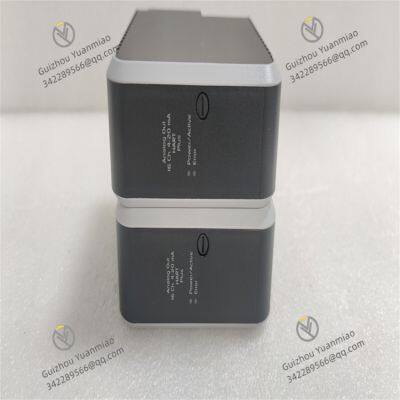Product Description
I. Overview
CE4005S2B4 is a high-performance digital input module, which is a key component in the field of industrial automation control. Its core function is to accurately collect various digital signals in industrial sites and reliably transmit these signals to the control system, providing accurate original data basis for the system's decision-making and control.
In industrial automation systems, front-end devices such as limit switches, photoelectric sensors, pressure switches, etc., will generate a large number of digital signals reflecting equipment status or production processes. The CE4005S2B4 module, like an "information entrance", can efficiently receive these signals. For example, in a mechanical processing production line, when a workpiece reaches a specified position, the limit switch is triggered and generates a digital signal. The module quickly collects this signal and transmits it to the control system. The control system judges the position of the workpiece based on this, and then issues instructions to control the equipment to perform the next processing operation, ensuring the orderly operation of the production line.

II. Technical Parameters
(1) Electrical Parameters
Input voltage range: Supports a wide voltage input of 12-24VDC, which can adapt to different power supply environments in industrial sites. Whether it is a sensor or switch device powered by 12VDC or 24VDC, it can be well compatible with this module, without the need for additional voltage conversion equipment, reducing the complexity and cost of system integration.
Input current: The rated current of each input channel is about 5-10mA. This low-power design can not only reduce the energy consumption of the module itself, but also reduce the load requirements on the front-end signal source, ensuring that various small sensors and other devices can stably output signals and ensuring the accuracy of signal collection.
Number of channels: Equipped with 16 independent digital input channels, which can collect 16 different digital signals at the same time. In medium-sized industrial control scenarios, such as an assembly line with multiple detection points, it can meet the needs of synchronous collection of status signals from multiple positions and multiple devices, realizing centralized data collection and management.
(2) Physical Parameters
Dimensions: The module has an external size of 220×60×30mm, with a compact structure. When the internal space of the industrial control cabinet is limited, it can be flexibly installed, which is convenient for reasonable layout with other control modules, power supplies and other equipment, improving the utilization rate of the internal space of the control cabinet and simplifying the wiring and maintenance of the system.
Weight: Approximately 350g, very light. During installation, disassembly and transportation, operators can operate easily, reducing the labor intensity of installation and maintenance, and at the same time reducing the load requirements on the installation bracket, making system installation more convenient.
Installation method: Adopts standard 35mm DIN rail installation, which conforms to the general installation specifications in the field of industrial automation. Simply clip the module into the rail to complete the initial fixation. The installation process is simple and fast, and it is convenient for adding, reducing or adjusting the position of the module according to system requirements in the later period, enhancing the scalability and maintenance convenience of the system.

(3) Environmental Parameters
Operating temperature range: Can work stably in extreme temperature environments from -30°C to +75°C. Even in cold northern outdoor industrial facilities or high-temperature metallurgical workshops, the module can maintain normal signal collection function, ensuring that the control system can obtain on-site information in real time and ensuring the continuity of production.
Humidity adaptation: Can operate reliably in an environment with a relative humidity of 0%-95% (non-condensing). In humid southern factories or industrial scenarios involving water vapor, such as near the cleaning link in food processing workshops, the moisture-proof design of the module can effectively prevent the internal circuit from being damaged due to moisture, prolonging the service life of the module.
Protection level: Reaches IP20 protection level, which can effectively block the intrusion of solid foreign objects with a diameter greater than 12mm, and is suitable for installation in relatively closed environments such as inside control cabinets. It can provide basic protection for the internal circuit components of the module, avoiding the impact on module performance due to the entry of larger particles such as dust.
III. Functional Features
(1) High-precision Signal Collection
Fast response capability: The input response time of the module is short, usually within 1ms. When the status of equipment in the industrial site changes and generates digital signals, the module can quickly capture these signal changes, ensuring that the control system can obtain the latest on-site information in time and make rapid control decisions. For example, in a high-speed packaging production line, it can timely collect the signal of completed packaging and control the subsequent sorting equipment to act in time.
Anti-interference design: Adopts photoelectric isolation technology to electrically isolate the input signal from the internal circuit of the module, with an isolation voltage of up to 2500VAC. This design can effectively suppress the influence of electromagnetic interference, surges and other interference signals in the industrial site on the module, ensuring that the collected digital signals are true and reliable, avoiding signal misjudgment caused by interference, and improving the control accuracy of the system.

(2) Powerful Diagnostic Functions
Channel status indication: Each input channel is equipped with an independent LED indicator light. Through the on-off state of the indicator light, operators can intuitively understand whether each channel has signal input, which is convenient for quickly judging the working state of the channel. During system debugging or fault Investigation��,it can quickly locate the problematic channel, improving work efficiency.
Fault self-diagnosis: Built-in perfect fault diagnosis circuit, which can monitor the power supply status of the module and the working status of the internal circuit in real time. When the module has problems such as abnormal power supply and internal circuit faults, it will timely feedback fault information through specific signals or indicator lights, facilitating maintenance personnel to quickly find and deal with faults, and reducing system downtime.
(3) Flexible System Adaptation
Wide protocol support: Compatible with mainstream industrial communication protocols such as Modbus RTU and EtherNet/IP, and can seamlessly interface with control systems such as PLC and DCS of different brands and types. In industrial automation systems composed of multiple brands of equipment, it can smoothly realize data transmission and interaction, ensuring the integrity and coordination of the system.
Configurability: Supports flexible configuration of parameters such as input filter time of the module through programming software. According to different on-site environments and signal characteristics, adjusting the filter time can effectively filter out high-frequency interference or spike pulses in the signal, improving the stability of signal collection. For example, in an environment with many strong interference sources such as motors, appropriately increasing the filter time can avoid false collection of interference signals.

IV. Common Faults and Solutions
(1) Abnormal Signal Collection
Fault phenomenon: The module cannot collect one or more input signals, or the collected signals are unstable and frequently false alarms.
Possible causes:
Input signal source failure: Front-end sensors, switches and other devices are damaged and cannot output signals normally.
Connection line problems: The signal transmission line has open circuit, short circuit or poor contact, resulting in the signal not being able to be transmitted to the module normally.
Module channel damage: The circuit components of the corresponding input channel inside the module are damaged and cannot receive signals.
Solutions:
Check the signal source: Use tools such as a multimeter to detect the output signal of the front-end equipment to confirm whether it is normal. If the equipment is damaged, replace the corresponding sensor or switch.
Check the line: Check the connection of the signal transmission line, check whether the cable is damaged or broken, and whether the connector is loose or oxidized. Repair or replace the open or short-circuited lines, and reinforce the loose connectors to ensure reliable line connection.
Test the module channel: Connect a normal signal source to the suspected faulty channel and observe whether the module can collect signals normally. If the channel is confirmed to be damaged, try to replace the module or contact professional maintenance personnel for repair.
(2) Communication Faults
Fault phenomenon: The module cannot establish a communication connection with the control system, or data loss, transmission errors, etc. occur during communication.
Possible causes:
Incorrect communication parameter settings: The communication baud rate, parity, address and other parameters of the module and the control system are inconsistent, resulting in failure to communicate normally.
Communication line faults: The communication cable is damaged, the connector is in poor contact, or the wiring is unreasonable, which is affected by strong electromagnetic interference and affects signal transmission.
Module communication interface failure: The communication chip or interface circuit of the module is damaged, resulting in inability to transmit data.
Solutions:
Check communication parameters: Check and ensure that the communication parameters of the module and the control system are completely consistent, including baud rate, parity, address, etc. After resetting the parameters, restart the device and try to establish communication.
Check the communication line: Replace the communication cable to ensure that the connector is firmly connected. Avoid parallel routing of communication lines with strong interference sources such as power cables to reduce electromagnetic interference. Use a dedicated communication tester to detect the signal transmission quality of the line and repair the problematic line.
Repair or replace the module: If the communication problem cannot be solved after the above checks, it may be a fault in the communication interface of the module. At this time, you can contact the supplier for repair or replace with a new module.

(3) Power Supply Faults
Fault phenomenon: The module cannot be powered on normally, or the indicator light does not light up or works unstable after power on.
Possible causes:
Power supply failure: The output voltage of the external power supply is unstable, the voltage value is not within the input voltage range of the module, or the power supply itself is damaged.
Power connection problems: The power line connection is loose, in poor contact, or the cross-sectional area of the power cable is insufficient, resulting in excessive voltage drop.
Module power interface damage: The power input interface or internal power circuit of the module is damaged, unable to receive power input normally.
Solutions:
Check the power supply: Use a multimeter to measure the output voltage of the power supply to confirm whether it is within the range of 12-24VDC and stable. If the power supply is faulty, replace it with a qualified one.
Check the power connection: Ensure that the power line connection is firm, without looseness or poor contact. If the cross-sectional area of the power cable is too small, replace it with a suitable specification cable to reduce voltage loss.
Repair the module: If it is suspected that the module's power interface or internal power circuit is damaged, contact professional maintenance personnel for testing and repair, and replace the module if necessary.


Emerson KJ3222X1-BA1 Analog Input HART Module
Emerson KJ3242X1-BA1 Fieldbus H1 Series 2 Module
Emerson KJ4002X1-BA1 Vertical Right Side 8-Wide Carrier
Emerson KJ4110X1-BC1 System Power Supply
Emerson KJ4110X1-EA1 DeltaV PLC Module
Emerson PR6426/000-010+CON021 Eddy Current Sensor
Emerson PR9268/303-000 Electrodynamic Velocity Sensor
Emerson SLS1508 Logic Solvers
Emerson VE4001S2T2B6 Standard I/O Termination Block
Emerson VE4002S1T2B5 Standard I/O Termination Block
Emerson VE4003S2B1 Standard I/O Termination Block
Emerson VE4003S3B1 Standard I/O Termination Block
 yezi
Hi there! Welcome to my shop. Let me know if you have any questions.
yezi
Hi there! Welcome to my shop. Let me know if you have any questions.







